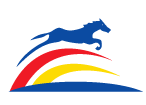Upcoming Events
Announcements
Please be informed that FEI has created an educational tool for CLEAN SPORT for infrastructure. For more details please visit http://youtu.be/o2i85rYgyPM
Dressage
What is Dressage
There are a lot of confused people wondering just what dressage is all about and for some reason it is often explained in a way to make it sound more confusing.
My interpretation is that it is training to enhance the natural movement of the horse. A horse likes showing off to other horses but it is difficult with a rider until the horse can learn to carry more weight with its hind legs and lighten the front end. Most horses are seen “jogging” with weight on the forehand, legs shuffling out behind and very little lift. Dressage encourages the horse to take strong upward steps with bounce.
The whole training process is designed to gradually strengthen the horse to be able to do a range of movements that require great physical strength and a good partnership between horse and rider to perform in natural beauty.
“The rider must balance the horse and aim to give lighter aids to gain a better result.”
To achieve this the rider must first be balanced and not rely on the reins or gripping for support. The rider must work on their balance in the seat to be sure they are not putting more weight in one seat bone than the other and that one hip is not further forward than the other. They must have equal weight: to hold the weight of the leg) in the stirrups and legs long and in the correct place for giving the aids.
The rider must carry their arms and hands and not lean on their own hips or rest on the horse. Correct position can be checked in any book and it is a gradual process to achieve it, cialis keep the primary aim of keeping the hands separate from the rest of the body right from the beginner stage. The legs must not grip but cuddle the horse and the rider should think of feeling the hair of the horse and not squashing the horses insides out.
When an aid is given it is an electric touch then off and try again. This needs to be reinforced with a touch of the whip (not sharply) if ignored.
Firstly “Ask” if ignored …”Tell” if ignored …”Demand” . If ignored… try the sequence again (perhaps it was misunderstood). It will encourage the horse to respond on the first gentle “ask” command but be sure the horse is not confused and never punish them in a way to cause stress.
The difference between ask and demand is the difference between an invisible and a visible aid. Consistency is very important. Never allow your moods to “demand” without “ask” and always reward by voice or a pat.

“The rider must assume the role of the teacher and gently explain what is required. “
No student likes to be yelled at for no reason, why should a horse be different. Whisper your aids… don’t shout them. They cannot speak our language, you must explain what you want and they will want to continue to learn.”
As the rider progresses from training the basic priorities of “forward, rhythm, balance and straightness” they can start to encourage the horse to step under themselves more but the rider must be light in the saddle, very flexible in the lower back and have a light independent hand. Hold the reins as though you are holding a childs hand, if the horse leans, briefly drop the contact forward for a second and drive the horse under more (tap, tap, not squeeeezzzzzeeee). Do not pull the horse back, feel as though you are pushing the horse under and allowing the back to bow upwards.
A common beginner fault is to resume a “foetal” position and pull which makes the horses back bend the wrong way or hollow. The rider must open up and stretch tall, hips forward and in balance. The horse will become more comfortable to ride as they gain balance, rhythm and spring.
Collection is more difficult and an instructor will assist the rider to apply the corresponding restricting aids when the back foot lands and the propelling aids when the back foot is about to step forward. This is when the horses natural paces start to really improve and gives you bounceability. Any backward blocking of the rein will prevent the inside hind legs from coming forward properly.
Competition dressage is judged on the paces, impulsion, submission and the riders effectiveness over a series of carefully prepared test movements. It is the judges responsibility to give guidance to the rider to tell them if they have consolidated the horses correct training enough at the level required before advancing. The national levels are: preliminary, novice, elementary, medium and advanced. The international levels are Prix St George, Intermediaire 1, Intermediaie 11 and finally Grand Prix. Most competitors start off at unofficial levels before progressing to the more demanding official competitions.
Dressage is a sport of beauty and is only possible when there is a true partnership with the horse and rider. The skills are difficult but once learnt will help the rider to improve any horse and help both horse and rider enjoy any discipline.








